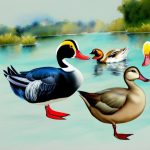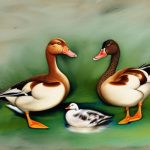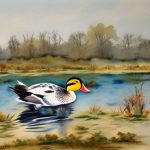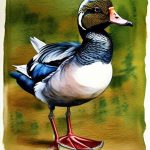Ducks are a diverse group of waterfowl that come in a wide variety of breeds, each with its own unique characteristics and traits. From domestic breeds raised for meat and eggs to wild breeds found in natural habitats, ducks have been an important part of human culture and agriculture for centuries. Understanding the different types of duck breeds can help farmers and enthusiasts choose the right breed for their specific needs and preferences.
Duck breeds can be categorized into several groups, including domestic, wild, ornamental, dual-purpose, egg-laying, and meat-producing breeds. Each group has its own distinct features and purposes, making them suitable for different roles on the farm or in a backyard setting. Whether you are interested in raising ducks for their meat, eggs, or simply as pets, there is a breed out there that will meet your needs. In this article, we will explore the various types of duck breeds, their characteristics, and the roles they play in agriculture and conservation.
Table of Contents
- 1 Domestic Duck Breeds
- 2 Wild Duck Breeds
- 3 Ornamental Duck Breeds
- 4 Dual-Purpose Duck Breeds
- 5 Egg-Laying Duck Breeds
- 6 Meat-Producing Duck Breeds
- 7 FAQs
- 7.1 What are the different types of duck breeds?
- 7.2 What are some characteristics of Pekin ducks?
- 7.3 What are some characteristics of Mallard ducks?
- 7.4 What are some characteristics of Muscovy ducks?
- 7.5 What are some characteristics of Rouen ducks?
- 7.6 What are some characteristics of Khaki Campbell ducks?
- 7.7 What are some characteristics of Runner ducks?
Key Takeaways
- There are various breeds of ducks, each with unique characteristics and purposes.
- Domestic duck breeds are raised for their meat, eggs, and ornamental purposes.
- Wild duck breeds are typically found in their natural habitats and are not commonly raised domestically.
- Ornamental duck breeds are valued for their aesthetic appeal and are often kept for exhibition or as pets.
- Dual-purpose duck breeds are raised for both meat and egg production, making them versatile for small-scale farming.
Domestic Duck Breeds
Domestic duck breeds are those that have been selectively bred by humans for specific traits such as meat production, egg-laying, or ornamental purposes. Some of the most popular domestic duck breeds include the Pekin, Muscovy, Khaki Campbell, and Rouen. Pekin ducks are known for their large size and white feathers, making them a popular choice for meat production. Muscovy ducks, on the other hand, are prized for their lean and flavorful meat, as well as their ability to forage for food. Khaki Campbell ducks are excellent egg layers, producing up to 300 eggs per year, while Rouen ducks are known for their beautiful plumage and calm temperament.
Domestic duck breeds come in a wide range of colors, sizes, and shapes, each with its own unique set of characteristics. Some breeds are better suited for free-range environments, while others thrive in confinement. When choosing a domestic duck breed, it is important to consider factors such as climate, available space, and intended use. Whether you are looking for a breed that excels in meat production, egg-laying, or simply as a backyard pet, there is a domestic duck breed that will meet your needs.
Wild Duck Breeds
Wild duck breeds, also known as dabbling ducks, are those that are found in natural habitats such as wetlands, marshes, and rivers. Some of the most common wild duck breeds include the Mallard, Wood Duck, Northern Pintail, and Gadwall. Mallards are perhaps the most well-known wild duck breed, with their distinctive iridescent green heads and mottled brown bodies. Wood ducks are known for their stunning plumage and preference for nesting in tree cavities near water. Northern Pintails are elegant and slender ducks with long necks and pointed tails, while Gadwalls are known for their subtle beauty and quiet nature.
Wild duck breeds play an important role in maintaining healthy ecosystems and biodiversity. They are also popular among birdwatchers and wildlife enthusiasts for their beauty and behavior. Many wild duck breeds are also hunted for sport and food, making them an important resource for both recreational and subsistence purposes. Understanding the behavior and habitat requirements of wild duck breeds is essential for their conservation and management, as well as for creating suitable environments for them to thrive.
Ornamental Duck Breeds
Ornamental duck breeds are those that are raised primarily for their aesthetic appeal and ornamental value. These breeds often have striking plumage patterns, unique coloration, or distinctive features that make them stand out from other duck breeds. Some popular ornamental duck breeds include the Mandarin Duck, Call Duck, Swedish Blue Duck, and Cayuga Duck. Mandarin ducks are known for their vibrant and intricate plumage, with males sporting elaborate patterns of orange, green, purple, and white feathers. Call ducks are small and compact with a wide range of color variations, making them popular choices for exhibitions and shows. Swedish Blue ducks have striking blue plumage with white markings, while Cayuga ducks have iridescent black feathers that shimmer in the sunlight.
Ornamental duck breeds are often kept for decorative purposes in ponds and gardens or showcased at poultry exhibitions and fairs. Their unique appearance and captivating beauty make them popular among collectors and enthusiasts who appreciate the diversity of duck breeds. While ornamental duck breeds may not be as prolific in meat or egg production as other domestic breeds, they play an important role in preserving genetic diversity and promoting appreciation for the natural world.
Dual-Purpose Duck Breeds
Dual-purpose duck breeds are those that are raised for both meat production and egg-laying purposes. These breeds are valued for their versatility and ability to provide a sustainable source of both meat and eggs for small-scale farmers and homesteaders. Some popular dual-purpose duck breeds include the Aylesbury, Silver Appleyard, Saxony, and Ancona. Aylesbury ducks are known for their large size and tender meat, as well as their ability to lay a respectable number of eggs. Silver Appleyard ducks are prized for their excellent meat quality and high egg production, making them a popular choice for small farms. Saxony ducks are known for their calm temperament and dual-purpose capabilities, while Ancona ducks are valued for their hardiness and adaptability to various climates.
Dual-purpose duck breeds offer a practical solution for farmers who want to maximize the productivity of their flock while minimizing inputs. By raising ducks that can provide both meat and eggs, farmers can diversify their income streams and reduce waste in their operations. Dual-purpose duck breeds also offer a sustainable alternative to single-purpose breeds by providing a balanced approach to poultry production.
Egg-Laying Duck Breeds

Egg-laying duck breeds are those that have been selectively bred for their ability to produce a high number of eggs throughout the year. These breeds are valued for their productivity and efficiency in converting feed into valuable protein-rich eggs. Some popular egg-laying duck breeds include the Khaki Campbell, Indian Runner, Welsh Harlequin, and Golden 300 Hybrid. Khaki Campbell ducks are renowned for their exceptional egg-laying capabilities, often producing upwards of 300 eggs per year. Indian Runner ducks are known for their upright posture and prolific egg production, while Welsh Harlequin ducks have a reputation for being excellent layers with calm dispositions. Golden 300 Hybrid ducks are prized for their high egg production and adaptability to various management systems.
Egg-laying duck breeds offer a sustainable solution for farmers and homesteaders who want to produce a consistent supply of fresh eggs for consumption or sale. Their efficient feed conversion rates and ability to thrive in diverse environments make them an attractive option for small-scale poultry operations. By choosing egg-laying duck breeds that are well-suited to their specific needs and management practices, farmers can optimize their egg production while minimizing inputs.
Meat-Producing Duck Breeds
Meat-producing duck breeds are those that have been selectively bred for their ability to grow quickly and produce high-quality meat. These breeds are valued for their efficient feed conversion rates and flavorful meat that is sought after by consumers around the world. Some popular meat-producing duck breeds include the Pekin, Muscovy, Moulard, and Cherry Valley. Pekin ducks are perhaps the most widely recognized meat-producing breed due to their rapid growth rate and tender flesh. Muscovy ducks are known for their lean and flavorful meat with minimal fat content, making them a popular choice among chefs and food enthusiasts. Moulard ducks are a cross between Muscovy and Pekin ducks, prized for their richly flavored meat and high breast yield. Cherry Valley ducks are bred specifically for meat production, with a focus on fast growth rates and efficient feed conversion.
Meat-producing duck breeds offer a valuable source of protein for consumers while providing farmers with a profitable enterprise. Their ability to thrive in various management systems and convert feed into high-quality meat makes them an attractive option for small-scale poultry operations. By raising meat-producing duck breeds that are well-suited to their specific needs and market demands, farmers can capitalize on the growing demand for sustainably produced duck meat.
In conclusion, duck breeds come in a wide variety of types with distinct characteristics that make them suitable for different roles on the farm or in a backyard setting. Whether you are interested in raising ducks for their meat, eggs, or simply as pets or ornamental birds there is a breed out there that will meet your needs. Understanding the different types of duck breeds can help farmers and enthusiasts choose the right breed for their specific needs and preferences. Ducks have been an important part of human culture and agriculture for centuries playing an important role in maintaining healthy ecosystems and biodiversity as well as providing a sustainable source of both meat and eggs for small-scale farmers and homesteaders.
In conclusion, duck breeds come in a wide variety of types with distinct characteristics that make them suitable for different roles on the farm or in a backyard setting. Whether you are interested in raising ducks for their meat, eggs, or simply as pets or ornamental birds there is a breed out there that will meet your needs. Understanding the different types of duck breeds can help farmers and enthusiasts choose the right breed for their specific needs and preferences. Ducks have been an important part of human culture and agriculture for centuries playing an important role in maintaining healthy ecosystems and biodiversity as well as providing a sustainable source of both meat and eggs for small-scale farmers and homesteaders. Overall, ducks are versatile and valuable animals that can contribute to a sustainable and diverse agricultural landscape.
If you’re interested in learning more about different types of duck breeds, you might also want to check out this informative article on Poultry Wizard about duck mating season. Understanding the mating season is crucial for breeders and enthusiasts alike. You can find the article here. It’s a great resource for anyone looking to delve deeper into the world of duck breeding and care.
FAQs
What are the different types of duck breeds?
There are many different types of duck breeds, including the Pekin, Mallard, Muscovy, Rouen, Khaki Campbell, and Runner ducks, among others.
What are some characteristics of Pekin ducks?
Pekin ducks are known for their white feathers, orange bills, and calm, friendly demeanor. They are also a popular choice for meat production.
What are some characteristics of Mallard ducks?
Mallard ducks are known for their colorful plumage, with the males having a distinctive green head. They are also a common wild duck species.
What are some characteristics of Muscovy ducks?
Muscovy ducks are known for their unique appearance, with red wattles around their bills and a distinctive caruncle on their faces. They are also known for their quiet nature and ability to fly.
What are some characteristics of Rouen ducks?
Rouen ducks are similar in appearance to Mallards, but they are larger and heavier. They are often raised for meat production.
What are some characteristics of Khaki Campbell ducks?
Khaki Campbell ducks are known for their khaki-colored feathers and their high egg production. They are a popular choice for egg-laying ducks.
What are some characteristics of Runner ducks?
Runner ducks are known for their upright, penguin-like stance and their ability to run rather than waddle. They are also known for their high egg production.
Meet Walter, the feathered-friend fanatic of Florida! Nestled in the sunshine state, Walter struts through life with his feathered companions, clucking his way to happiness. With a coop that’s fancier than a five-star hotel, he’s the Don Juan of the chicken world. When he’s not teaching his hens to do the cha-cha, you’ll find him in a heated debate with his prized rooster, Sir Clucks-a-Lot. Walter’s poultry passion is no yolk; he’s the sunny-side-up guy you never knew you needed in your flock of friends!







